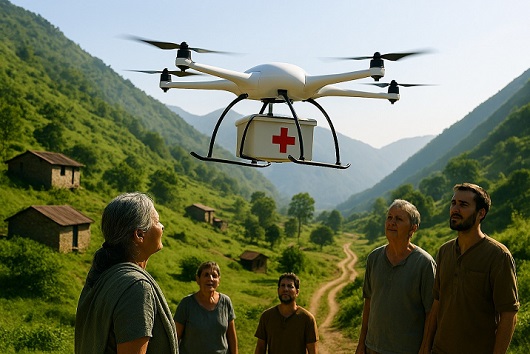Imagine a world where medicines, vaccines, and emergency medical supplies are delivered not by ambulance, but through drones. These flying machines cross forests, mountains, and rivers to reach the most remote corners of the country. In India, this vision is no longer futuristic. It’s already happening.
The “Medicine from the Sky” initiative is a collaboration between the World Economic Forum, local governments, Apollo Hospitals, HealthNet Global, and NITI Aayog. It is transforming the delivery of healthcare to some of the country’s most underserved populations.
From Ground to Sky: The Origins of the Initiative
In many parts of India, especially remote and mountainous areas, getting medical supplies to healthcare centers is a real challenge. Poor roads — or no roads at all — often mean long delays. These delays can put lives at risk.
To address this, the World Economic Forum launched the Medicine from the Sky initiative in 2021. The concept was simple but impactful: use drones to deliver essential medicines directly to remote clinics. This cuts down travel time and overcomes the limitations of rough terrain.
The project began in Telangana. There, drones delivered over 300 types of medicines for vaccine trials. Encouraged by its success, the project expanded to Arunachal Pradesh — a region known for even tougher geography. It is already showing positive results.
- Completed over 650 flights
- Delivered more than 10,000 medical products
- Covered 15,000+ kilometers of mountainous terrain
What once took 8 hours by road can now be done in just 22 minutes. This shift, enabled by drone technology, has proven life-saving in emergencies.
Empowering Communities Through Drones Technology
One of the most powerful aspects of the project is its focus on community empowerment. The drones are not just flying machines. They’re part of a broader local ecosystem built on drone technology.
In Arunachal Pradesh, the initiative trained and employed 15 local youth. This includes Jasmine Nikh, the state’s first female drone pilot. These trained professionals manage drone operations and maintain equipment. They also coordinate with healthcare centers to ensure smooth delivery.
This use of drone technology is a catalyst for job creation and technology training. It promotes gender inclusion in areas where such opportunities are rare.
Environmental and Operational Efficiency
Another compelling benefit is the environmental impact. Unlike conventional delivery vehicles, drone technology uses electric-powered systems that produce zero CO₂ emissions during flight.
In addition to minimizing the healthcare sector’s carbon footprint, drone delivery reduces traffic congestion. It also lowers dependence on fossil fuels.
As drone technology evolves, there’s potential for even more groundbreaking uses. These include flying ambulances, airborne diagnostic labs, and AI-enabled drone swarms for rapid emergency response.
By replacing long, fuel-intensive road trips with fast, clean airborne deliveries, drone technology supports India’s sustainable development goals. It also increases the resilience of its healthcare infrastructure.
Recognition and Global Implications
The effects of Medicine from the Sky have been recognized. The project received an award from the International Civil Aviation Organization (ICAO) for its innovative use of drones for health system logistics.
The ICAO also issued a global call to action. It encouraged governments and the private sector to accelerate the use of drone-based solutions for public services.
Sebastian Buckup of the World Economic Forum stated:
“The pilot programmes in India, particularly in the greater Himalayan region, provided a vivid example of how drone technology can solve the problem of distance by delivering health care products to people in their homes.”
This recognition shows how other countries, such as Nepal, Bhutan, and parts of Africa, could replicate India’s drone-based solution.
Looking Ahead: The Future of Advanced Air Mobility
With Medicine from the Sky proving successful, the World Economic Forum is moving forward with AVIATE India. This is an Advanced Air Mobility (AAM) initiative.
It includes exploration of drone technology for agriculture, urban planning, environmental monitoring, freight, and passenger transport.
As the ecosystem matures, drone technology will increasingly integrate into traditional healthcare systems. It will improve pandemic response, disaster management, and public health readiness.
Conclusion: A Shift in Life Saving in the Skies
Medicine from the Sky proves that with local cooperation and policy innovation, drone technology can be harnessed to solve critical healthcare challenges.
For remote areas in India, the sky is no longer the limit. It is a lifeline.
This is not just a project. It is a model for global change, making healthcare quicker, cleaner, and fairer — one flight at a time.
References
World Economic Forum: How medicines ‘dropping from the sky’ are transforming healthcare in India



